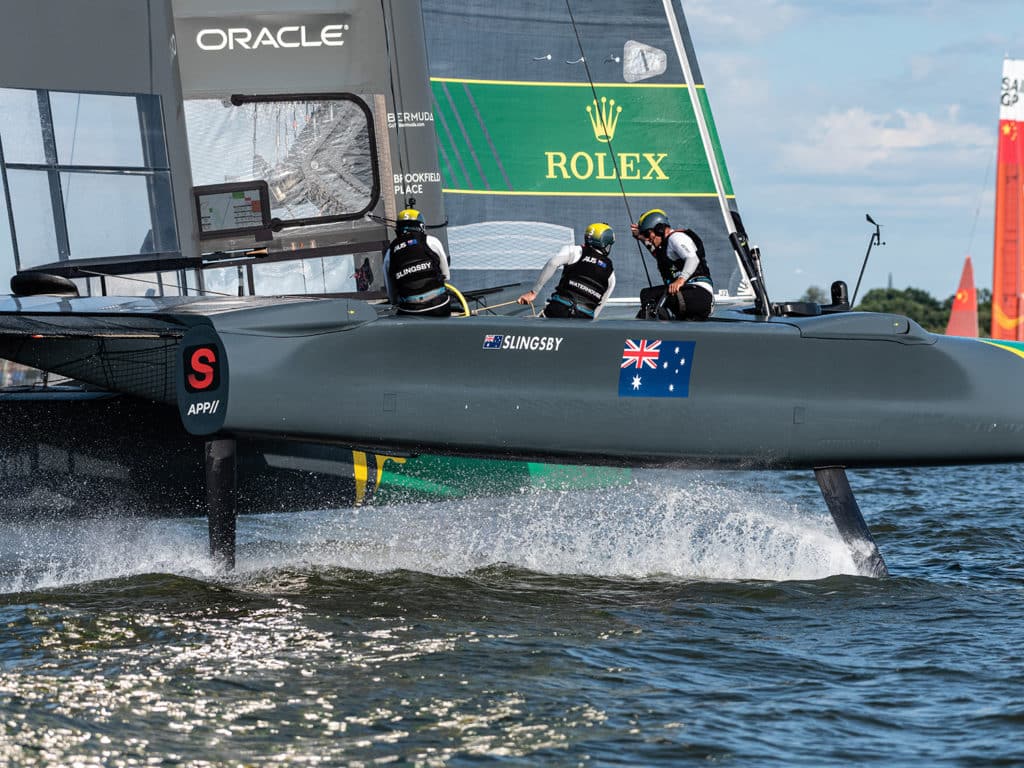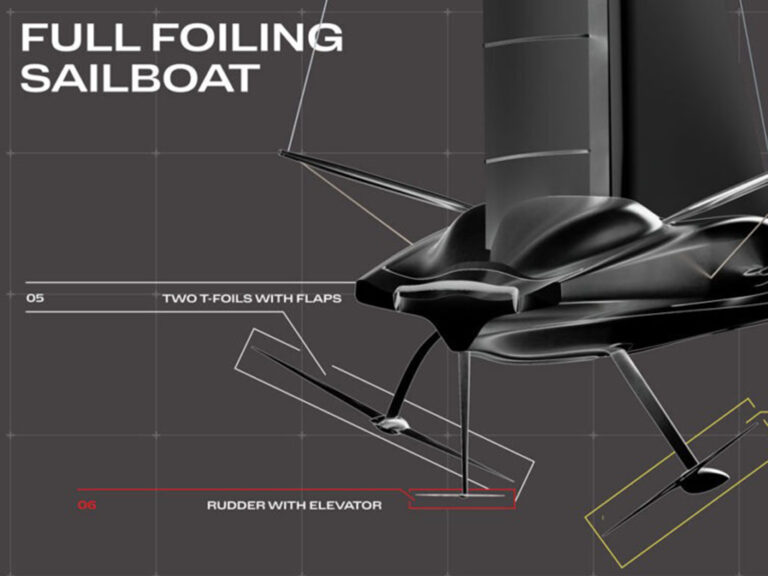
Flight control to Major Tom…Flight control to Major Tom…take your protein shake and put your helmet on… Commencing countdown, wing trim on…check ignition and may God’s love be with you… ”
Sure, it’s a slightly bastardized version of the David Bowie classic, one not likely stuck in Team Australia SailGP flight controller Jason Waterhouse’s head every time he steps into the cockpit of the team’s F50, alongside his co-pilots—skipper Tom Slingsby and wing trimmer Kyle Langford. Still, Bowie’s “Space Oddity” is fitting song for the modern day SailGP foil operator.
When it comes to managing the 50-footers, Waterhouse’s role as designated flight controller is now more critical than ever. Ongoing improvements to the F50’s complex control system has meant more responsibility placed into the flight controller’s hands—literally—since the SailGP series started in Sydney in February. Whereas Team Australia helmsman Tom Slingsby was once more active with managing ride height and other attitudes, the responsibility is now Waterhouse’s responsibility.
“It’s been a full reversal since Sydney, where I was tactician and only flew the boat during maneuvers when both boards were in the water,” Waterhouse says, “whereas Tommy would fly the boat in the straight line and mainly around the whole course.”
After the Sydney event, organizers changed the flight-control interface from a joystick device to what Waterhouse describes as “the pepper cracker,” a small unit with arms on each side of the consol. He now predominantly flies around the course 100-percent of the time, except when sprinting to the new side during a maneuver.
“Initially, the flight controller couldn’t fly the boat properly [in Sydney and San Francisco],” Waterhouse says. “We couldn’t catch the hull quick enough so they changed the interface and the valves on the daggerboard rake cylinders, which makes it easier to fly.”
Waterhouse compares his control unit to a Formula steering wheel, where critical and on-demand adjustments are finger-tip accessible: for example, daggerboard rake, board up and down, wing inverter, rudder set up, rudder differential.
“Those are the main functions at our disposal from the console, which is pretty cool,” he says. “It does get confusing to remember where they are, but eventually muscle memory takes control.”
There’s also a control panel on the inboard side of each cockpit which provide fine-tune settings, such as the angle at which the daggerboard enters the water, how fast the rudders swap over with each tack, “nitty gritty settings that are quite important, but are pre-set before the race,” Waterhouse says.
The erratic and unpredictable conditions SailGP teams experienced on the Hudson River during race days of the New York SailGP event put extra pressure on Waterhouse and other flight controllers who have to anticipate changes in wind strength and the dynamic forces that result. “Those are the hardest conditions,” says Waterhouse. “What you don’t see are the force changes; with every puff and shift, or wing-trim change or steering movement, the loading on the board changes, which changes your lift, so you’re always trying to counteract all those variables to keep the boat flying. It’s bloody hard.”
Anticipation is one thing, and reacting to split-second changes is another, and this is where onboard communication with others on the boat comes into play. Either wing trimmer Kyle Langford or helmsman Tom Slingsby are calling the gusts and lulls, so Waterhouse’s job is responsibility is knowing what the next adjustment will be. He’s also looking to the grinders in front of him. “If they’re spinning the handles, and the boat’s not coming up,” he says, “I have to load up the boat with more side load for it to help them get the weather hull up.”
The stock F50 of the SailGP uses only two daggerboard types: big, high-drag, high lift foils for light air and smaller strong-wind foils that make the boat easier to control a high speeds. Each set, says Waterhouse, requires different handling. Although they’re similar when used in their designated wind range, when the foils are carried to the extremes of their design purpose, the boat can be extremely difficult to fly well. In New York on the first day of racing, for example, all teams used light-air foils in order to compensate for the lulls, but the gusts were hard to handle.
“We had the massive boards on doing 49 knots at times, which makes it really hard because there is such a massive lifting surface under the water. Any angle change is so exponential that the boat just bites and jumps. The bottom marks the hardest to deal with because we’re adding so much side load to the boat, and the outside foil is providing lift.”
With the short courses and high-paced maneuvering of the SailGP racecourses, Waterhouse says onboard communication must be efficient as well. The Australians have been working on it, as have the other teams. “For each of us to do our jobs better, we have to communication what we’re thinking,” Waterhouse says. “The art of flight control is getting the optimum performance, but the centerboard is so narrow that if you’re 10 centimeters too low, you’re slow, and if it’s 10 centimeters too high, you’re crashing. The comms I have to get from skipper is what he feels on the rudder. If I fly to high, we lose rudder steerage, and that’s when everything goes pear shaped and people get hurt.”
With five crew on the headset communication units, chatter must be minimized, and if one were to listen in, you’d hear terms such as “lost rudders” or “popping,” which is not exactly traditional sailing parlance. “If I hear that, it’s my cue to rake the board back and really get it going,” Waterhouse says.
Everyone’s still learning, he adds, which is why there are still dramatic speed and handling differences in the fleet, especially with the less experienced Chinese and French teams. So far in the series, both Team Australia and Team Japan have set the bar, benefiting from experience with boats in the 35th America’s Cup. Each team has subtly different style asd well. “You can tell the Japanese and the British are really pushing the foiling tack with the flight controller,” says Waterhouse, “whereas we think that laying the boat down, just out of the water, and doing a nice clean pop is more consistent, although it may not be optimum. Team Japan, for example, might have two stellar tacks but then have one shocker, so we’re trying to keep ours consistent.”









